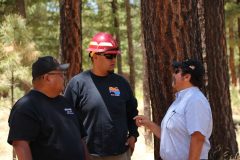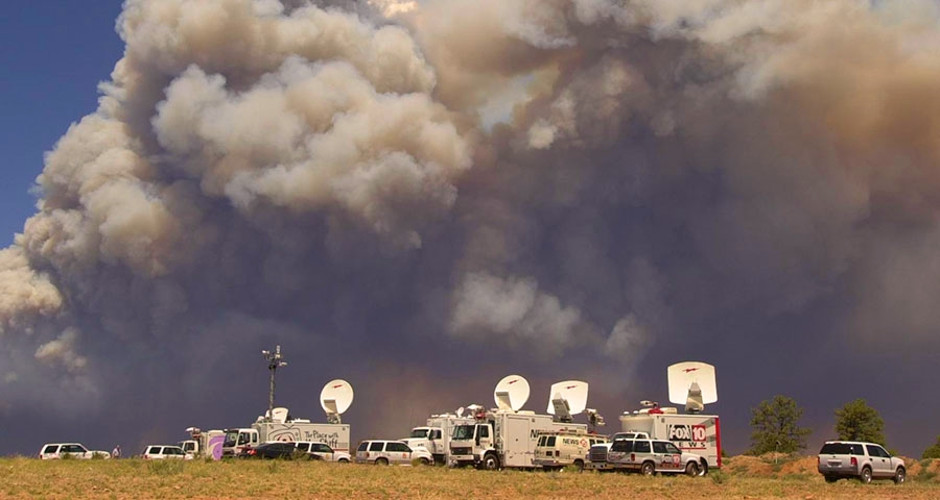— Published with Permission of FreeRangeReport.com —
“On the Rattlesnake Fire, it didn’t burn hardly any on the White Mountain Apache side because it burned up to their prescribed burn and pretty much went out,” said Mr. Best. “If we would have treated our side of the fence at the same time they treated their side of the fence, the whole thing might have been just a little fire.”
Apaches stave off wildfires with timber industry, active forest management
SAN CARLOS, Ariz. — The catastrophic blazes that thrive in eastern Arizona’s thickly forested yet arid landscape have a way of fizzling once they jump from the dense national forests to the Apache reservations, and that’s not by chance.
On a scorching summer day with fire danger at the extreme level, forestry superintendent Michael Gutierrez and his crew spent the morning chain-sawing the overgrown junipers surrounding Seneca Lake on the San Carlos Apache Indian Reservation.
Soil conservationist Paul Buck discussed his experiments in fighting tough alligator juniper using the terrestrial version of the herbicide Round-Up, and forest manager Dee Randall explained how the scrubby trees could be converted into slabs and sold for furniture as part the tribal timber business.

Such wildfire prevention techniques might alarm environmentalists, but the San Carlos Apache have their own agenda: Keep the forests healthy, protect their sacred sites, and bring back the plants and grasslands that flourished before the reservation was established in 1934.
“The Apaches believe the health of the people is tied to the health of the land,” said Mr. Randall. “We want the reservation to look the way it did in the pre-reservation days. Everything we do is just to help us get a more healthy forest. That’s the whole goal.”
The Apache learned the hard way. The two worst fires in Arizona history — the 2011 Wallow Fire and the 2002 Rodeo-Chediski Fire — erupted in the backyard of the Fort Apache Indian Reservation, twin sister of the San Carlos reservation and home of the White Mountain Apache Tribe.
Robert Lacapa, a White Mountain tribal member who recently retired after a life in fire and forestry, said the tribe overhauled its approach after the Rodeo-Chediski Fire blackened 468,638 acres of national forest and tribal lands.
“After Rodeo-Chediski, what we did differently is we looked at the areas that survived the burn,” said Mr. Lacapa, a former Bureau of Indian Affairs forest manager at the Fort Apache Agency. “A lot of them survived because we had done fuel treatments — prescribed burns, timber harvests, timber stand improvements, multiple projects.”
The conclusion: “Multiple treatments are more effective than one. You need to do multiple treatments,” Mr. Lacapa said.
The strategy paid off nine years later during the Wallow Fire. The most destructive fire in state history, the Wallow charred 538,049 acres in Arizona and New Mexico but faded when it crossed into the reservation’s tidier woodland mosaic.
“Biggest wildfire in Arizona history couldn’t burn Fort Apache Reservation,” The Arizona Republic said in a July 2017 headline.
It was the same with the Rattlesnake Fire, which started in April on the Fort Apache side and spread to the San Carlos. Nearly all of the damage was on the neighboring Apache-Sitgreaves National Forest. The wildfire ultimately burned 26,072 acres at a cost of about $11 million.
Steve Best, Apache-Sitgreaves forest supervisor, credited the tribe for putting in the work to tackle the needles, branches and fallen trees that litter the forest floor to the tune of 2 tons per acre per year.
“On the Rattlesnake Fire, it didn’t burn hardly any on the White Mountain Apache side because it burned up to their prescribed burn and pretty much went out,” said Mr. Best. “If we would have treated our side of the fence at the same time they treated their side of the fence, the whole thing might have been just a little fire.”


